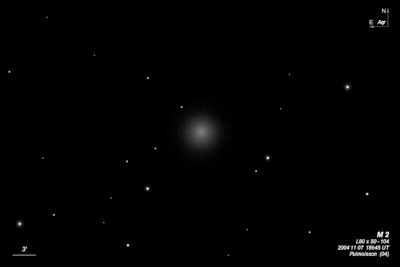
Jean-Dominique Maraldi discovered M2 = NGC 7089 = h2125 on 11 Sept 1746 at the Paris Observatory while tracking Comet de Chéseaux of 1746. Charles Messier made an independent discovery on 11 Sep 1760. William Herschel observed the globular on 31 Jul 1783 with his 12-inch (small 20-foot) and commented "I can count 18 or 20 of the stars." Using his 18.7" on 12 Aug 1785 (sweep 425), he recorded "an extremely rich, very compressed and very brilliant cluster of extremely small stars, 7 or 8' in diameter. The stars are plainly to be seen, especially on the borders where they are not so condensed." On 4 Sep 1799 he observed M2 with the 48-inch (40-foot), and logged "It appeared very brilliant and luminous. The scattered stars were brought to a good, well determined focus, for which it appears that the central condensed light is owing to a multitude of stars that appeared at various distances behind and near each other. I could actually see and distinguish the stars even in the central mass. The Rev. Mr. Vince, Plumian Profession or Astronomy at Cambridge, saw it in the same telescope as described."
On 12 Sep 1830 (sweep 288), JH reported "A most superb cluster; round; stars eS; 12, 13, 14m; they are evidently globularly arranged, and not internally condensed towards the centre more than the spherical form would make them appear to be; but in the middle they blend into a blaze of light. It is like a heap of fine sand! With 9 inches aperture I can just see the stars; with 6 it is resolvable."
200/250mm - 8" (10/4/80): intense core, faint halo. Faint stars are resolved in the outer halo.
300/350mm - 13" (7/16/82): high resolution at edges, partially resolved core, symmetrical halo.
400/500mm - 17.5" (8/2/86): over 100 stars resolved over the entire disc at 286x. Superb view at this magnification.
900/1200mm - 48" (10/26/11): hundreds of relatively bright stars resolved in this large, beautifully symmetric globular. The intensely bright core is overlaid with a mat of resolved stars.
Notes by Steve Gottlieb